Dental Bridge
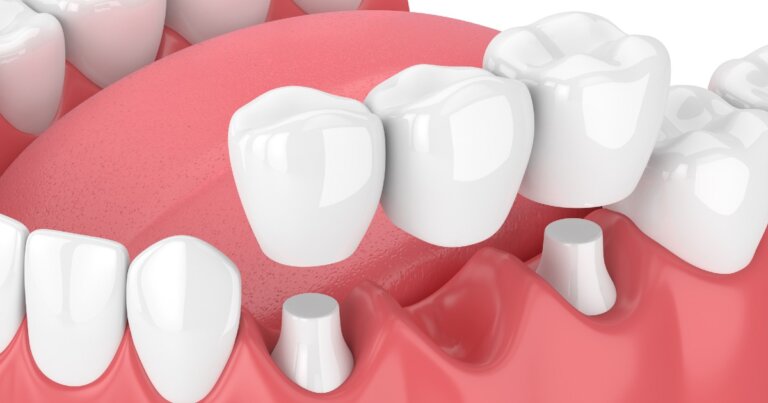
What Is A Dental Bridge?
When it comes to maintaining a healthy and beautiful smile, Dental Bridges play a crucial role in restoring missing teeth. Whether you’ve lost a tooth due to decay, injury, or other reasons, a dental bridge is an effective solution that can help you regain your confidence and oral functionality.
A dental bridge is a prosthetic device that literally “bridges” the gap created by one or more missing teeth. It consists of two main components: dental crowns, also known as abutments, and a false tooth, referred to as a pontic. The abutments are placed on the teeth adjacent to the gap, acting as anchors for the bridge, while the pontic fills in the space left by the missing tooth. Dental bridges can be made from various materials, including porcelain, ceramic, metal alloys, or a combination of these.
Before you deciding on whether A Dental Bridge are right for you, there are some things you should know:
- Who Needs A Dental Bridge?
- What Are The Advantages Of A Dental Bridge?
- What Are The Different Types Of Dental Bridges?
- How Much Does A Dental Bridge Cost?
- What Are The Steps In The Dental Bridge Procedure?
- Can I Have A Dental Bridge If I Am Pregnant?
- How Long Does A Dental Bridge Last?
- What Are Common Problems with A Dental Bridge?
If you have any further questions about A Dental Bridge or other dental services offered at Atlas Dental, please contact us.

Free phone consultation
Are you missing teeth and have questions about Dental Bridges? Schedule a free phone consultation with our GTA dentist.

5 star google reviews
Our patients love us! See why people are choosing Atlas Dental for Dental Bridges.

Book Emergency Bridge visit online
Have a problem with your Dental Bridge? Book An Emergency Dental Appointment Online.
Who Needs A Dental Bridge?
A dental bridge is a versatile tooth replacement option that can benefit various individuals who have experienced tooth loss. Here are some common scenarios where a dental bridge may be recommended:
- Individuals with Missing Teeth: A dental bridge is an excellent choice for individuals who have one or more missing teeth. It fills the gap created by the missing tooth, preventing neighboring teeth from shifting and maintaining the alignment of your dental arch.
- Those Seeking Aesthetic Improvements: If you’re self-conscious about a gap in your smile due to missing teeth, a dental bridge can help enhance your appearance. It is designed to blend seamlessly with your natural teeth, providing a natural-looking and aesthetically pleasing result.
- Patients with Chewing and Speaking Difficulties: Missing teeth can significantly impact your ability to chew food properly and articulate speech. A dental bridge restores oral functionality, allowing you to enjoy a wider range of foods and speak clearly.
- Individuals with Jawbone Preservation Concerns: When a tooth is lost, the underlying jawbone may begin to deteriorate due to lack of stimulation. By replacing the missing tooth with a dental bridge, the pressure exerted during chewing stimulates the jawbone, promoting its preservation and preventing further bone loss.
- Patients Who Prefer Non-Removable Solutions: Unlike removable options like dentures, dental bridges are fixed in place. This means you don’t have to worry about removing them when brushing your teeth or for soaking outside your mouth overnight. They offer convenience and stability, making them a popular choice for those who prefer a permanent tooth replacement solution.
- Candidates with Sufficient Oral Health: To receive a dental bridge, it’s essential to have a healthy foundation of remaining teeth and gums. Your dentist will evaluate your oral health to ensure that a dental bridge is a suitable treatment option for you.
- Individuals Looking for a Time-Efficient Solution: Compared to other tooth replacement procedures, such as dental implants, getting a dental bridge usually requires fewer visits to the dentist and a shorter treatment time. If you’re looking for a more time-efficient solution to replace missing teeth, a dental bridge may be the right choice.
By considering these factors and discussing them with your dentist, you can determine if a dental bridge is the ideal option for restoring your smile and improving your oral health. If you have further questions about a Dental Bridge, please contact us.
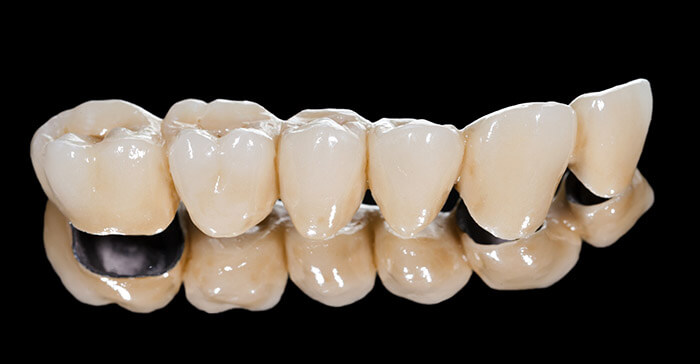
What Are the Advantages Of A Dental Bridge?
A dental bridge offers numerous advantages for individuals seeking tooth replacement options. Let’s explore the key benefits of choosing a dental bridge:
- Restores Missing Teeth: Dental bridges effectively fill the gaps left by missing teeth, restoring a complete and natural-looking smile.
- Enhances Oral Functionality: By replacing missing teeth, dental bridges enable proper chewing and speaking, improving overall oral functionality.
- Prevents Shifting of Teeth: Dental bridges help maintain the alignment of surrounding teeth, preventing them from shifting into the empty space left by missing teeth.
- Supports Facial Structure: Missing teeth can lead to a sunken or aged appearance. Dental bridges provide support to the facial structure, helping to maintain a youthful and fuller facial profile.
- Improves Aesthetics: Dental bridges are designed to blend seamlessly with your natural teeth, enhancing the appearance of your smile and boosting your self-confidence.
- Offers Durability and Longevity: With proper care and oral hygiene, dental bridges can last for many years, providing a durable and long-term solution for tooth replacement.
- Enhances Speech: Missing teeth can impact speech clarity. By filling the gaps, dental bridges improve speech articulation and pronunciation.
- Comfortable and Natural Feel: Dental bridges are custom-made to fit your mouth comfortably, giving you a natural feel when eating, speaking, and smiling.
- Convenient and Non-Removable: Unlike removable dentures, dental bridges are fixed in place, eliminating the need for removal, adhesives, or soaking. They offer convenience and stability.
- Preserves Jawbone Health: By replacing missing teeth, dental bridges help stimulate the underlying jawbone, preventing bone loss and preserving overall oral health.
Choosing a dental bridge as your tooth replacement option can bring about significant improvements in both the functionality and appearance of your smile. Consulting with your dentist will help determine if a dental bridge is the right choice for your specific needs and dental condition. If you have further questions about the advantages of a Dental Bridge, please contact us.
What Are The Different Types Of Dental Bridges?
There are several types of dental bridges available, each designed to meet specific needs. They include Traditional dental bridges, Cantilever dental bridges, Maryland dental bridges, and Implant-supported dental bridges:
Traditional Dental Bridges
This is the most common type of dental bridge. It consists of a false tooth (pontic) held in place by dental crowns (abutments) that are placed on the adjacent teeth on either side of the gap. The abutment teeth are prepared by removing some enamel to accommodate the crowns, which are then cemented onto the prepared teeth, with the pontic bridging the gap between them.
Traditional dental bridges come in different varieties:
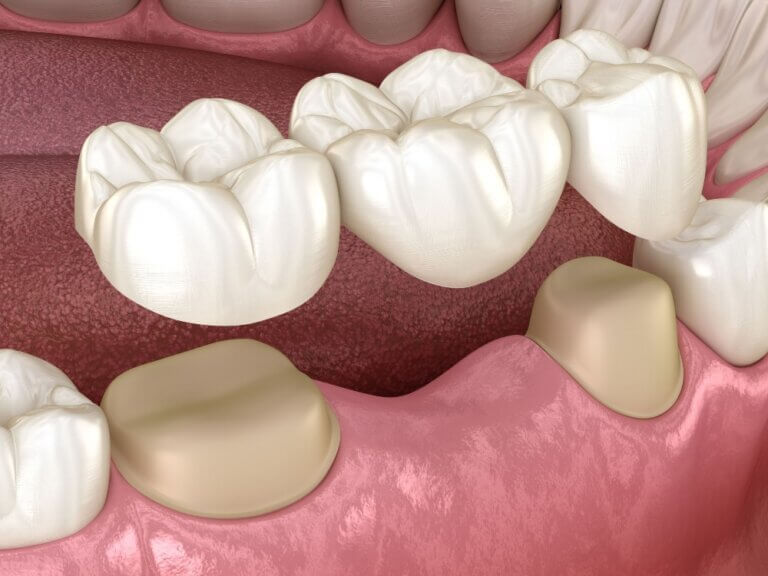
Cantilever Dental Bridges
A Cantilever dental bridge is similar to a traditional bridge, but it is supported by a single abutment tooth instead of two. This type of bridge is used when there is only one adjacent tooth next to the gap. However, it is less common due to the potential for increased stress on the supporting tooth.
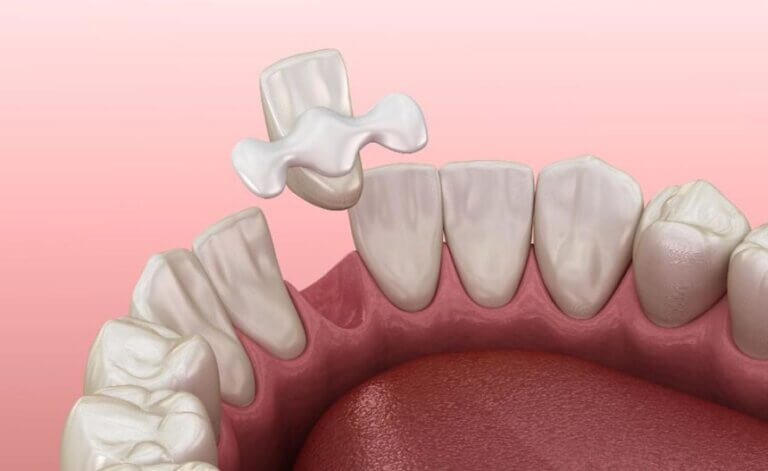
Maryland Dental Bridges
A Maryland dental bridge involves a metal or porcelain framework bonded to the back of adjacent teeth using resin or other adhesive materials. It requires minimal preparation of the neighboring teeth, making it a conservative option. Maryland bridges are primarily used for replacing missing front teeth.
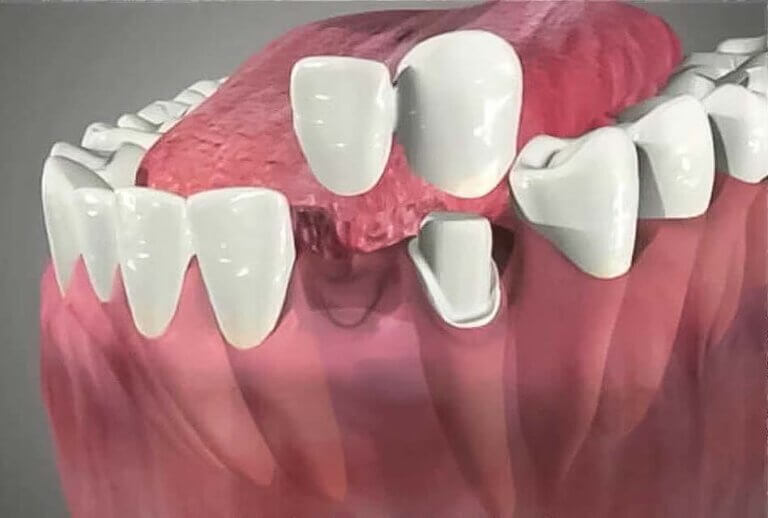
Implant-Supported Dental Bridges
In cases where multiple adjacent teeth are missing, an implant-supported bridge may be recommended. Dental implants are surgically placed in the jawbone to serve as artificial tooth roots, and the bridge is securely attached to the implants. This type of bridge offers excellent stability and does not rely on adjacent teeth for support.
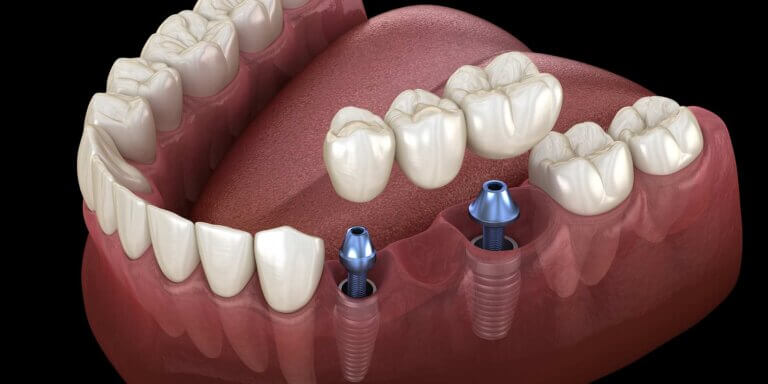
The choice of dental bridge type depends on factors such as the location of the missing teeth, the condition of the adjacent teeth, jawbone health, and individual preferences. Your dentist will evaluate your specific needs and recommend the most suitable type of bridge for you. If you have further questions about the different types of Dental Bridges, please contact us.
Cost of Dental Bridge
Dental Bridges rely on retainers (natural teeth) to support pontics (false floating teeth where a tooth is missing). Therefore, the price of a dental bridge will depend on the number of pontics and retainers. A 3-unit bridge, for example, would cost $1207+538+1207 plus dental lab fee (approximately $800), which is equal to $3752. The codes relevant to dental bridges in the Ontario Dental Association’s Suggested Fee Guide appear as follows:
Pontics, Porcelain/Ceramic/Polymer Glass
- 62501 – Pontics, Porcelain/Ceramic/Polymer Glass Fused to Metal: $538 + Dental Lab Fee
Retainers, Porcelain/Ceramic/Polymer Glass
- 67201 – Retainer, Porcelain/Ceramic/Polymer Glass: $1207 + Dental Lab Fee
Other factors that could affect the cost of dental bridges include local dental association fee guides, dental bridge materials, qualifications of the dentist or prosthodontist, dental laboratory fees, and whether you have dental insurance coverage.
The Ontario Dental Association’s Suggested Fee Guide is a proposed fee structure that dentists in Ontario may or may not follow. Please consult with your dentist about fees before going ahead with treatment.
Dental bridges are sometimes considered a supplementary service by dental insurance plans and may or may not be covered by your dental insurance. Be sure to find out from your dental insurance plan provider how much you are eligible for before going ahead with dental treatment. Your dentist can help you submit an predetermination to your dental insurance.
For patients without dental insurance, Atlas Dental is pleased to offer dental financing through Dentalcard. Affordable payment plans start at 7.95% for terms of 6 months to 6 years. To learn more about Dentalcard dental treatment financing, follow this link.
What Are The Steps In The Dental Bridge Procedure?
The dental bridge procedure typically requires two visits. Here’s an overview of the process:
First Appointment
- Initial Consultation and Examination: During the first visit, your dentist will evaluate your oral health, assess the condition of your remaining teeth, and discuss the suitability of a dental bridge for your specific case. X-rays or other imaging may be taken to aid in treatment planning. Please review these pre-operative instructions before your visit.
- Teeth Preparation: In order to create space for the dental bridge, the adjacent teeth on either side of the gap are prepared. This involves removing a small portion of enamel to accommodate the bridge’s crowns or abutments. Local anesthesia is used to ensure your comfort during this process.
- Impressions and Shade Matching: Impressions of your teeth are taken to create accurate molds for the dental bridge. These impressions capture the exact dimensions and shape of the prepared teeth and the gap between them. Additionally, the shade of your natural teeth is determined to create a bridge that seamlessly blends with your existing teeth.
- Temporary Bridge Placement: While the permanent bridge is being fabricated in a dental laboratory, a temporary bridge may be placed to protect the exposed teeth and gums. This temporary bridge is usually made of acrylic and is less durable than the final restoration.
Second Appointment
- Permanent Bridge Placement: Once your dental bridge is ready, you will return to the dentist’s office for its placement. The temporary bridge is removed, and the dentist ensures that the permanent bridge fits properly, both in terms of comfort and appearance. Adjustments may be made to achieve an optimal fit.
- Finalizing the Bridge: After confirming the fit, the dental bridge is permanently cemented or bonded into place. The dentist will check your bite and make any necessary adjustments to ensure that the bridge aligns properly with your natural teeth.
- Post-Treatment Care: Your dentist will provide post-treatment instructions on how to care for your new dental bridge. This typically involves maintaining good oral hygiene practices, including regular brushing, flossing, and attending routine dental check-ups and teeth cleanings.
By following these steps, your dentist can successfully restore your smile with a dental bridge, improving both the functionality and aesthetics of your teeth. If you have further questions about the Dental Bridge procedure, please contact us.
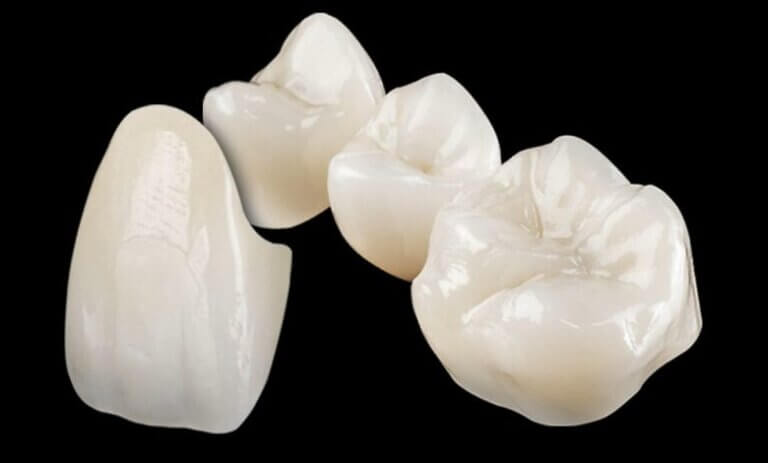
Can I Have A Dental Bridge If I Am Pregnant?
Pregnancy is a unique time when it comes to dental procedures. Here are some considerations regarding dental bridges during pregnancy:
- Safety of Dental Procedures: Generally, dental procedures, including dental bridge placement, are safe during pregnancy. However, it is important to inform your dentist about your pregnancy and any related concerns.
- Timing: The second trimester is often considered the ideal time for non-emergency dental treatments. By this time, the risk of potential complications is lower, and the discomfort experienced during the first trimester may have subsided.
- Consultation with Healthcare Providers: Before proceeding with a dental bridge, it is advisable to consult both your dentist and obstetrician. They can assess your overall health and provide guidance based on your individual circumstances.
- Local Anesthesia: Local anesthesia is commonly used during dental procedures, including dental bridge placement. The type and amount of anesthesia used will be determined based on your specific needs and the recommendations of your healthcare providers.
- Radiation Safety: Dental X-rays are usually avoided during pregnancy, especially during the first trimester. However, if necessary, special precautions such as using a lead apron and thyroid collar can minimize radiation exposure.
- Medication Considerations: Your dentist will take into account any medications or pain management options that are safe during pregnancy. They will recommend suitable alternatives or adjust the treatment plan accordingly.
- Oral Hygiene and Prevention: Good oral hygiene practices and preventive measures, such as regular brushing, flossing, and attending dental check-ups, are particularly important during pregnancy to maintain oral health and reduce the risk of dental issues.
- Hormonal Changes and Gum Health: Pregnancy hormones can affect gum health, increasing the risk of conditions like gingivitis or pregnancy gingivitis. Proper oral hygiene and professional dental cleanings can help manage these concerns.
- Stress and Dental Anxiety: Pregnancy can be a time of heightened emotions and stress. If dental anxiety is a concern, communicate this to your dentist, who can offer techniques to help you feel more comfortable during the procedure.
- Individual Considerations: Every pregnancy is unique, and your dentist will consider your specific health conditions, trimester, and overall well-being to determine the most suitable approach for your dental bridge treatment.
By discussing your pregnancy and dental needs with your healthcare providers, you can make informed decisions about receiving a dental bridge while pregnant, ensuring the best possible outcome for both you and your baby. If you have further questions about getting a Dental Bridge during pregnancy, please contact us.
How Long Does A Dental Bridge Last?
The longevity of a dental bridge depends on various factors, including maintenance, oral hygiene, and individual circumstances. Here are some key points to consider regarding the lifespan of a dental bridge:
- Lifespan Expectations: On average, a well-maintained dental bridge can last between 5 to 15 years or even longer. The lifespan can vary based on the materials used, oral hygiene practices, and the individual’s oral health.
- Material Durability: Dental bridges made from high-quality materials such as porcelain, ceramic, or metal alloys tend to be more durable and long-lasting. These materials are designed to withstand the daily pressures of chewing and biting.
- Oral Hygiene Practices: Proper oral hygiene is crucial for maintaining the longevity of a dental bridge. Regular brushing, flossing, and rinsing with mouthwash help prevent plaque buildup and maintain the health of the supporting teeth and gums.
- Dental Check-ups: Regular dental check-ups allow your dentist to monitor the condition of your dental bridge, identify any potential issues early on, and provide necessary adjustments or repairs. It is recommended to visit your dentist every six months or as advised.
- Supporting Teeth Health: The health of the adjacent teeth that support the dental bridge plays a significant role in its longevity. It is important to maintain good oral health, address any dental issues promptly, and follow your dentist’s recommendations for oral care.
- Bite and Chewing Habits: Excessive or irregular forces placed on the dental bridge due to grinding, clenching, or improper biting habits can impact its lifespan. Using a mouthguard, if recommended by your dentist, can help protect the bridge from excessive forces.
- Lifestyle Factors: Certain lifestyle factors such as smoking or consuming excessive amounts of staining substances like coffee or red wine can affect the appearance and longevity of dental bridges. Limiting these habits and practicing good oral care can help preserve the bridge.
- Regular Maintenance: Along with routine oral hygiene, your dentist may recommend specific maintenance steps for your dental bridge, such as using special floss or interdental brushes to clean hard-to-reach areas. Following these post-insert instructions can contribute to its longevity.
- Individual Variations: Each person’s oral health and habits are unique, which can influence the lifespan of a dental bridge. Your dentist will consider your specific circumstances to provide personalized recommendations for care and maintenance.
While a dental bridge is a durable tooth replacement option, it is important to remember that its longevity is influenced by various factors. By maintaining good oral hygiene, seeking regular dental care, and following your dentist’s instructions, you can maximize the lifespan of your dental bridge. If you have further questions about a Dental Bridge, please contact us.
What Are Common Problems With A Dental Bridge?
While dental bridges are generally reliable and durable, there are some common issues that may arise. Here are a few potential problems associated with dental bridges:
- Bridge Discomfort: In some cases, a dental bridge may cause discomfort or soreness, especially during the initial adjustment period. This can often be resolved by making minor adjustments to the bridge or using over-the-counter pain relievers as recommended by your dentist.
- Poor Fit or Misalignment: Occasionally, a dental bridge may not fit perfectly or may become misaligned over time. This can result in discomfort, difficulty with biting or chewing, or aesthetic concerns. Your dentist can make the necessary adjustments to ensure a proper fit and alignment.
- Bridge Fracture or Damage: While dental bridges are designed to be strong, they may occasionally experience fractures or damage due to accidents, trauma, or excessive force. In such cases, it is important to consult your dentist for evaluation and appropriate repair or replacement.
- Tooth Decay Under Bridge: If proper oral hygiene practices are not followed, the supporting teeth of a dental bridge may be at risk of decay. Thorough brushing, flossing, and regular dental check-ups are essential to maintain the health of the supporting teeth and prevent decay.
- Gum or Tissue Irritation: In some instances, the gums or surrounding tissues may become irritated or inflamed due to poor oral hygiene or improper bridge fit. Maintaining good oral hygiene and regular dental visits can help prevent or address these issues.
- Bridge Failure or Loosening: While relatively rare, bridge failure or loosening can occur over time. This may be due to factors such as normal wear and tear, inadequate oral hygiene, or underlying issues with the supporting teeth or jawbone. Regular dental check-ups are important to detect and address any signs of bridge failure early on.
- Allergic Reactions: In rare cases, individuals may experience allergic reactions to the materials used in dental bridges, such as metals or ceramics. If you have known allergies, inform your dentist to ensure appropriate material selection.
- Esthetic Concerns: Over time, the color or appearance of the dental bridge may not match the surrounding natural teeth as perfectly as before. This can be addressed through professional teeth cleaning, polishing, or, if necessary, replacement of the bridge.
If you experience any problems or concerns with your dental bridge, it is important to consult your dentist promptly. Early detection and appropriate intervention can help resolve issues and ensure the long-term success of your dental bridge. If you have further questions about common problems associated with a Dental Bridge, please contact us.
We also think you’ll like…
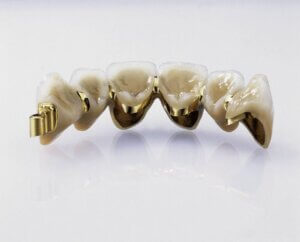
Porcelain Fused To Metal Dental Bridge
Porcelain Fused To Metal Dental Bridge What Is A Porcelain Fused To Metal Dental Bridge? If you’re missing one or more teeth, a dental bridge
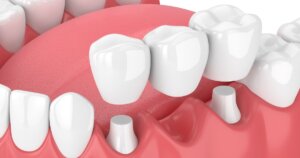
Dental Bridge Home Care Instructions
Dental Bridge Home Care Instructions What You Should Do After Receiving Your Dental Bridge Dental bridges, also known as fixed partial dentures, literally bridge the

Dental Bridge Pre-Operative Instructions
Dental Bridge Pre-Operative Instructions What You Should Do Before Your First Dental Bridge Appointment Dental bridges, also known as fixed partial dentures, literally bridge the
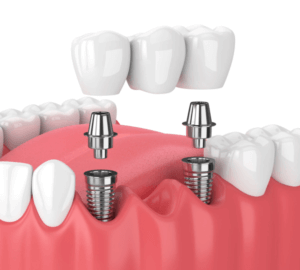
Dental Implant Bridge Home Care Instructions
Dental Implant Bridge Home Care Instructions What You Should Do After Receiving Your Dental Implant Bridge A Dental Implant Bridge is a prosthetic device used
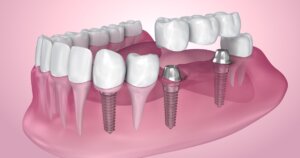
Dental Implant Bridge
Dental Implant Bridge What Is A Dental Implant Bridge? A dental implant bridge is a prosthetic device used to replace one or more missing teeth
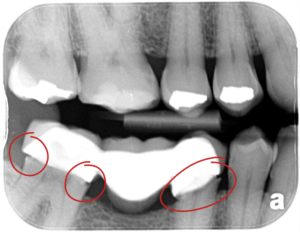
Dental Bridge Open Margin
Dental Bridge Open Margin What Is A Dental Bridge Open Margin? A Dental Bridge is a prosthetic dental appliance that is used to replace one

